If you thought you couldn’t use lean cuts of beef to make awesome pot roast, think again. This Traeger smoked pot roast recipe does just that, transforming lean chuck tender roast into fall-apart-tender shredded beef with carrots, potatoes, and a rich beef gravy. Every serving is packed with 34 grams of protein and only 8 grams of fat.
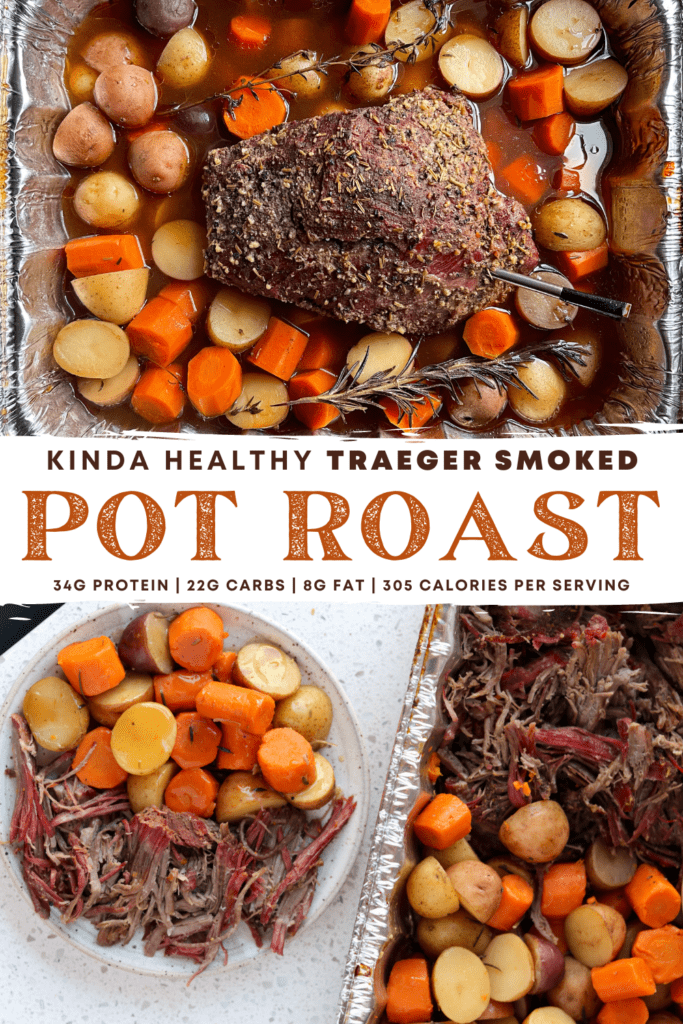
Best Cut of Beef for Healthy Pot Roast
While pot roast is typically made with chuck roast, I’ve found you can still make a tender, juicy pot roast with lean beef cuts. This recipe calls for chuck tender roast, which has 24 grams of protein, 6 grams of fat, and 150 calories per 4 oz (raw). My Ninja Foodi pot roast recipe calls for bottom round roast (25 grams of protein and 6 grams of fat) or eye of round roast (26 grams of protein and 2 grams of fat).
Compare all these to chuck roast (21 grams of protein and 21 grams of fat per 4 oz), and you can see how many calories you can save going with leaner options.

All three options will work great for making smoked pot roast, and I’m betting you’ll be able to find at least one at any grocery store. I found the chuck tender roast at Target, of all places.
Pro tip: Patting the surface of the roast dry with a paper towel will make it easier to handle when trimming any fat and help the seasoning stick to the surface.
Pot Roast Seasoning
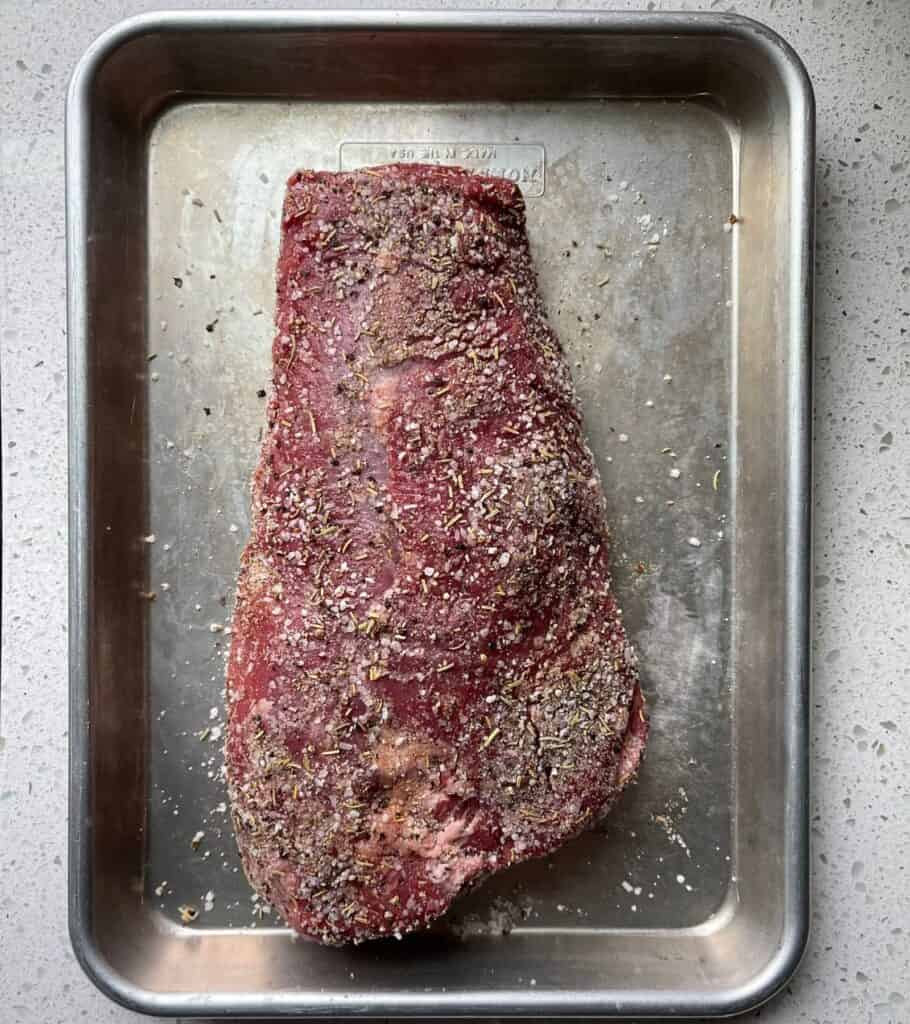
I’ve experimented with both braising the pot roast with onion and garlic and using onion and garlic powder as a rub, and I prefer the latter. Especially with a smoked pot roast. They add so much to the seasoning rub and help develop a nice crust on the grill.
Aside from garlic and onion powder, you’ll need salt, pepper, and dried rosemary or herbs of your choice. Feel free to get creative with your pot roast rub. Some people like to add things like brown sugar, paprika, and more herbs to their pot roast seasoning.
Smoked Chuck Tender Roast
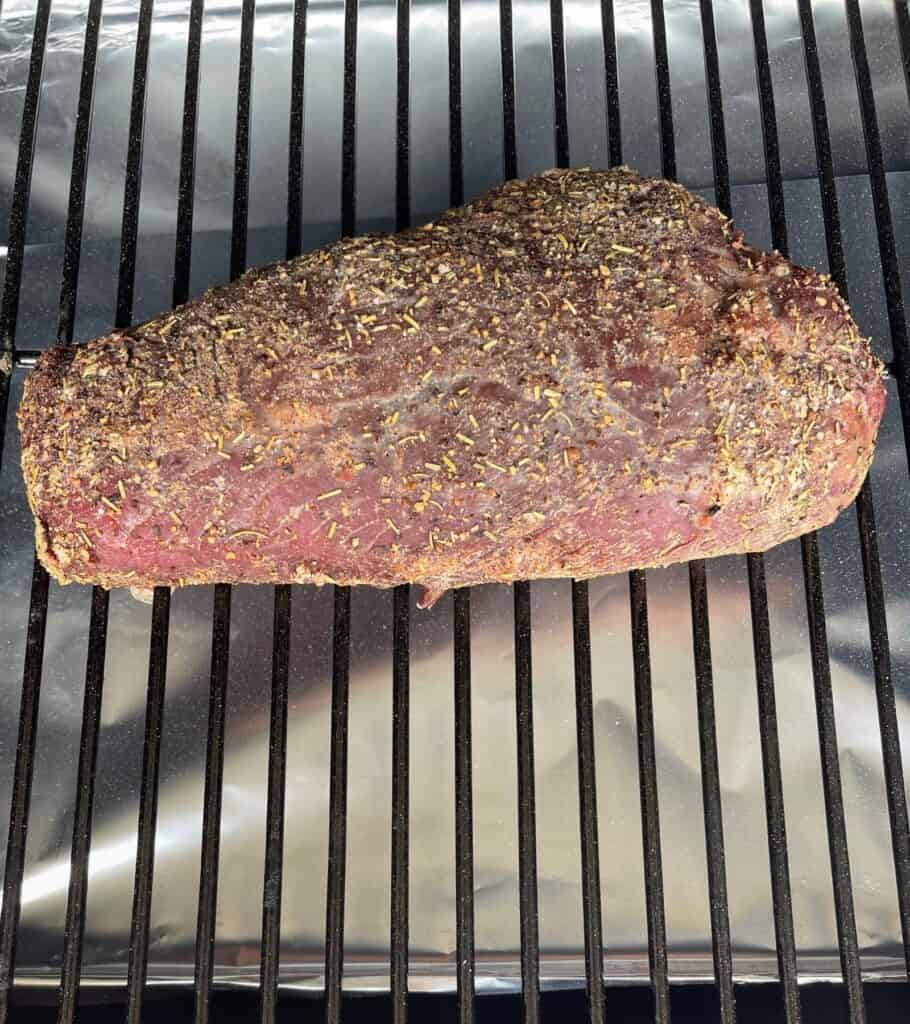
In this stage, you’re looking to develop a slight crust and give the roast time to pick up some great wood-fire smoky flavor. You’re not worried about internal temperature at this point, as the roast will finish cooking in a braising liquid with vegetables.
Braising on the Traeger
The recipe calls for carrots and potatoes, but you can play around with different vegetables. Since we’re making a healthier pot roast here, you could borrow from the pressure cooker roast recipe I mentioned early. That recipe uses daikon radish and/or turnips in place of potatoes. You could also use the multi-colored baby radishes from my air fryer roasted radishes recipe. All these substitutes will remove around 10 grams of carbs per serving.
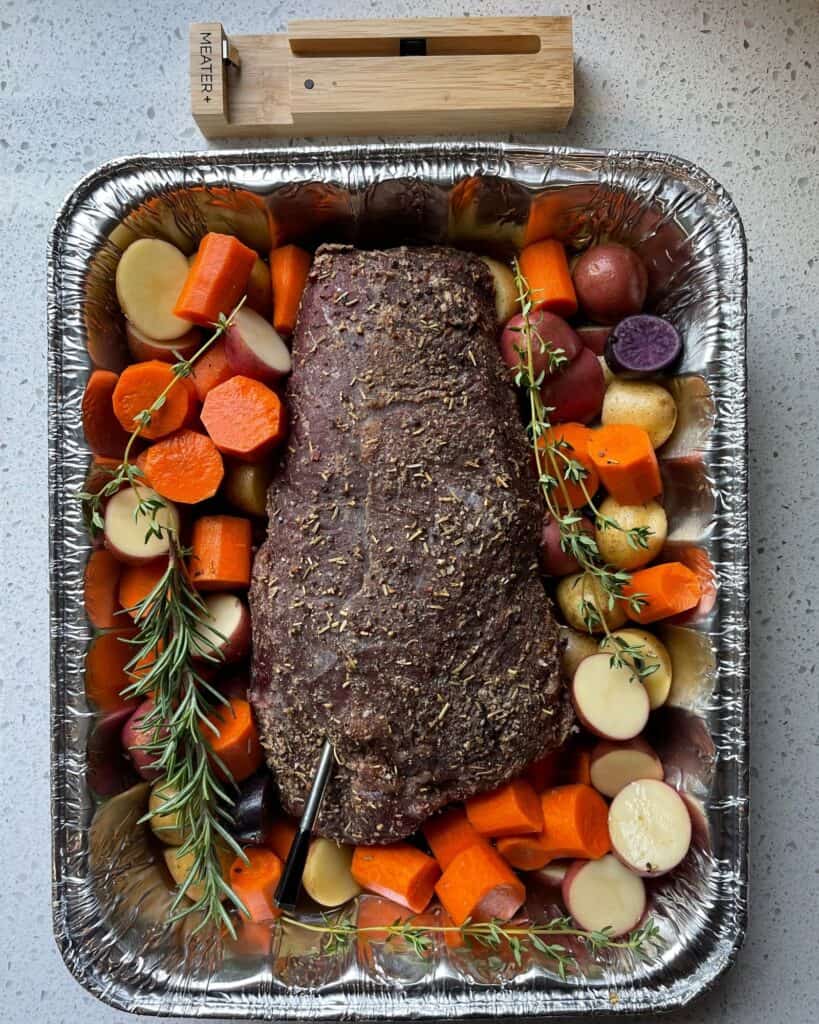
For the braising liquid, I used my go-to Kettle & Fire beef bone broth to create a rich and flavorful base. Instead of red wine, I used a combination of red wine vinegar (cabernet sauvignon, to be specific) and Worcestershire sauce.
I used a few sprigs of thyme and one sprig of rosemary, but you can tweak it to fit your flavor preference. There’s really no wrong move here. Bay leaves are a great flavor enhancer for braises, but I was fresh out.
Internal Temperature for Pot Roast
If you’re a pro when it comes to smoked brisket, you’re familiar with the magic that happens when cooking tougher cuts of beef to higher internal temperatures like 200ºF. We’re using the same principles with this smoked pot roast, aiming for collagen to transform into gelatin and muscle fibers to relax and soak up all the juices. To get a better understanding of this process read this: What Temperature Does Collagen Break Down in Brisket.
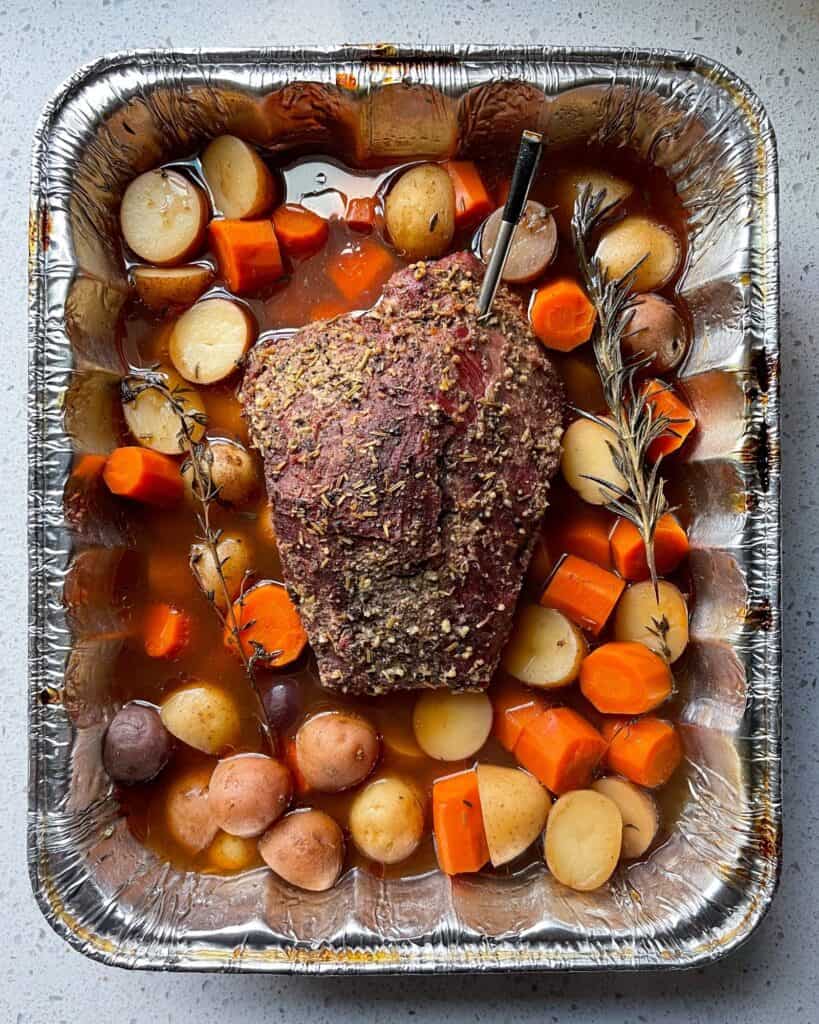
To avoid poking too many holes in the foil cover or lifting the foil to check the temperature of the roast periodically, I used the wireless Meater Plus thermometer. You can monitor from an app on your phone the entire time and even set temperature notifications. If you’re just working with the Traeger probe, you should be able to pierce a hole in the foil for the cord and be fine.
Making Gravy with Pot Roast Juices
Once the smoked pot roast comes off the grill, you’ll want to let it rest to allow all the muscle fibers to relax and juices to settle. If you want gravy, it’s easy to lift a corner of the foil and pour the remaining juices into a pot over medium heat. Just stir every now and then and reduce it down to a gravy.
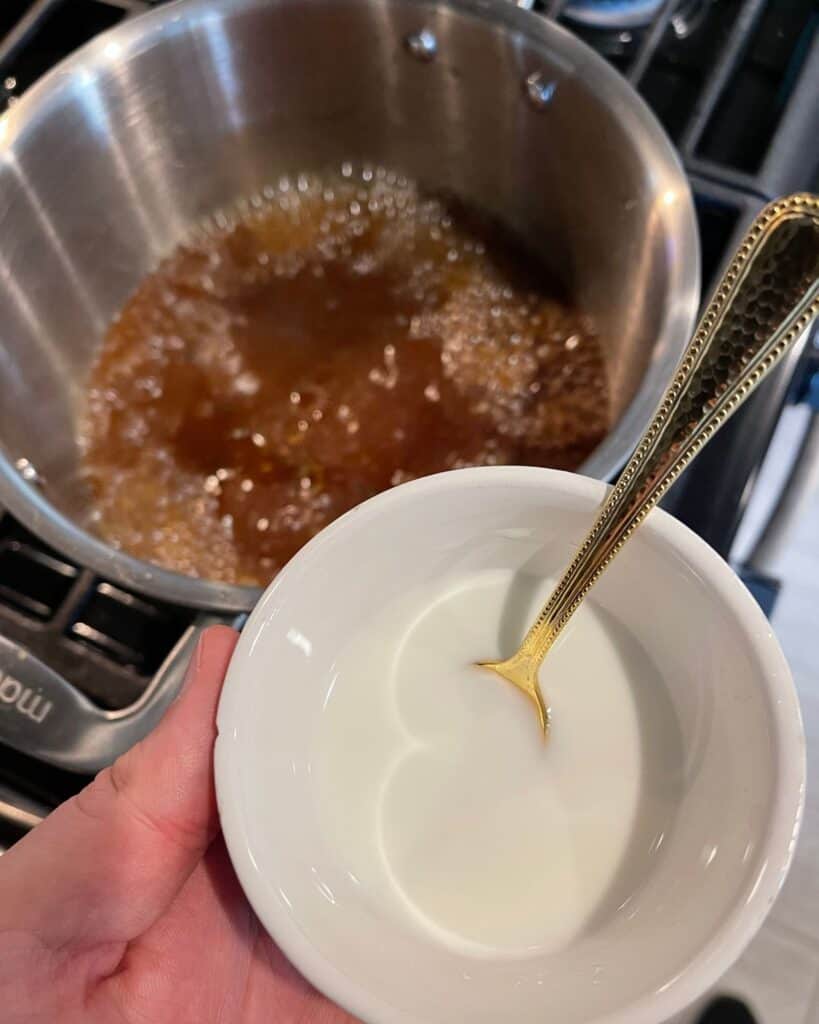
I like to speed things up with a cornstarch slurry then reduce to a simmer until the roast is ready to serve.
Do I have to reduce the remaining juices?
You can totally skip the gravy step and let everything hang out together after coming off the smoker. I served my pressure cooker pot roast (pictured below) with grilled bread to help sop up the broth.
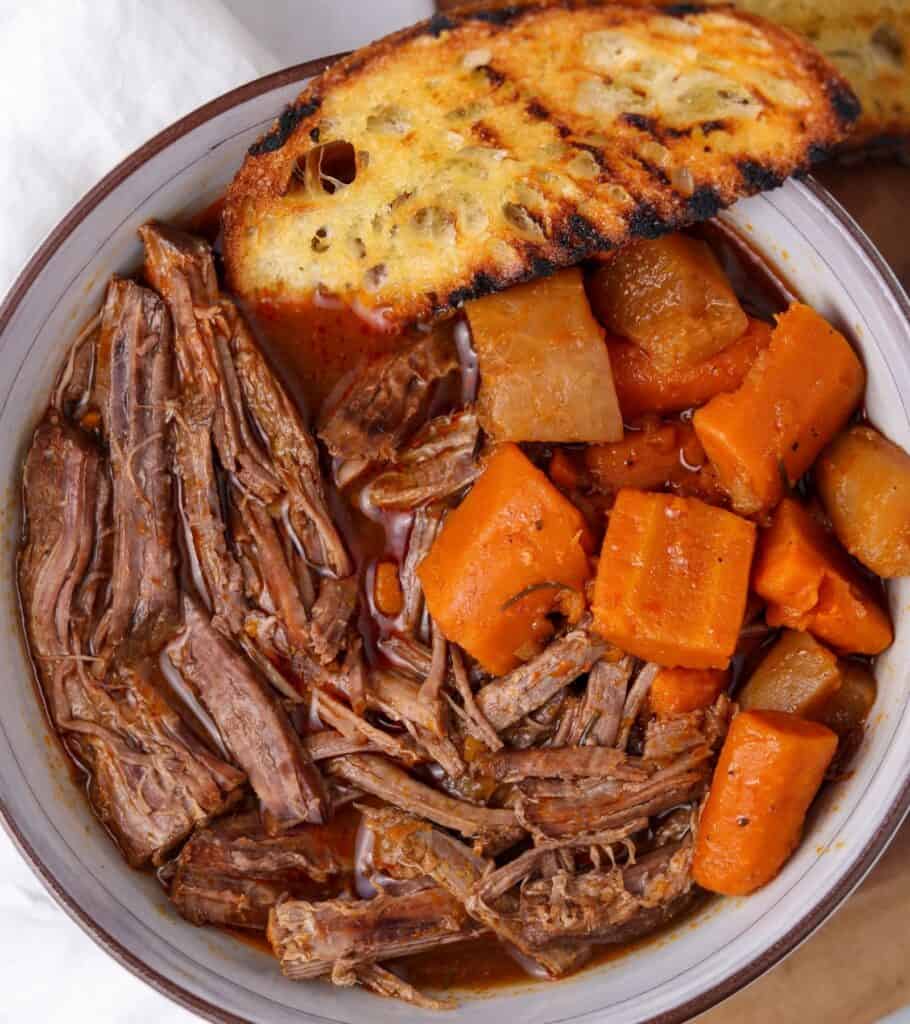
To keep things on the healthier side, here’s a roundup of low carb bread options. You could also make something like low carb rolls or high protein bread.
Other Ways to Serve Pot Roast
If you swap the potatoes for radishes or turnips, you could really splurge with some mashed potatoes. I feel like mashed potatoes and pot roast are an iconic Americana dinner option. To keep things lower carb, you could always make a hybrid potato and cauliflower mash.
More sides for pot roast:
- bacon cheddar mac and cheese
- roasted brussels sprouts
- cauliflower mac and cheese
- air fryer green beans
- the best broccoli of your life
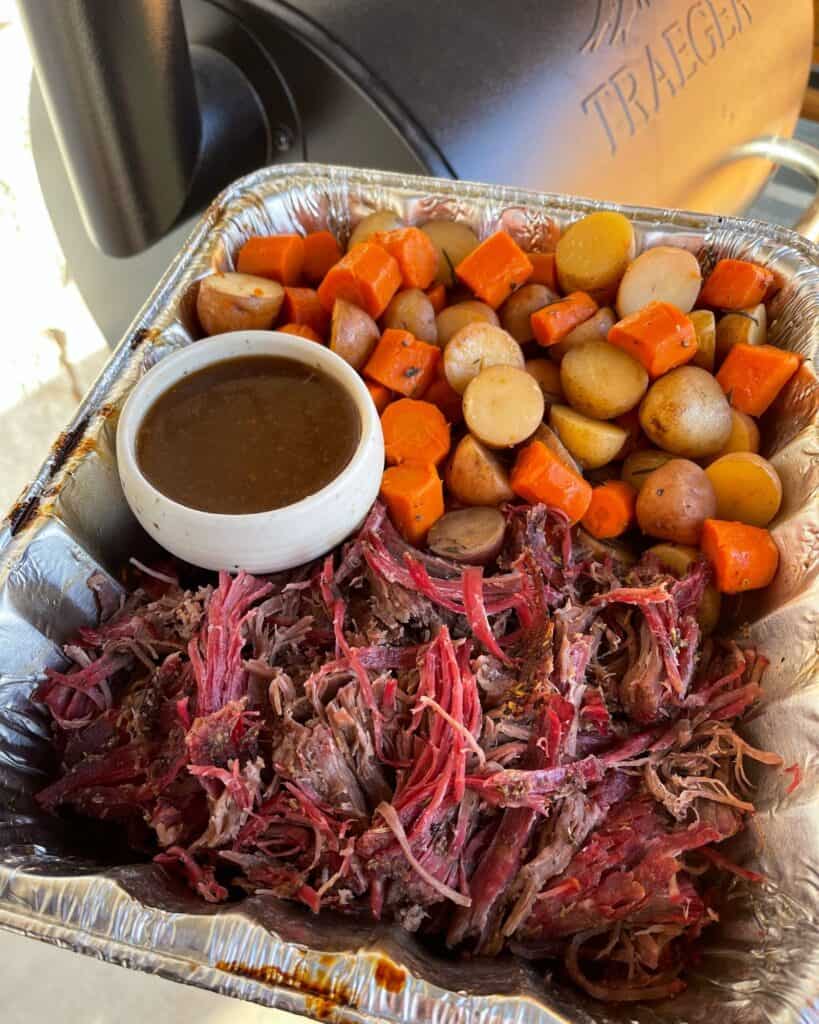
Then of course we’ve already touched on the bread options. The starchy, crunchy stuff just goes so well with pot roast. It soaks up any residual gravy and contrasts the soft texture of the veggies.
However you serve your smoked pot roast, I’d love to hear about it. Come back and let me know in a comment or recipe review! You can also leave any recipe questions in the comments at the bottom of the post.
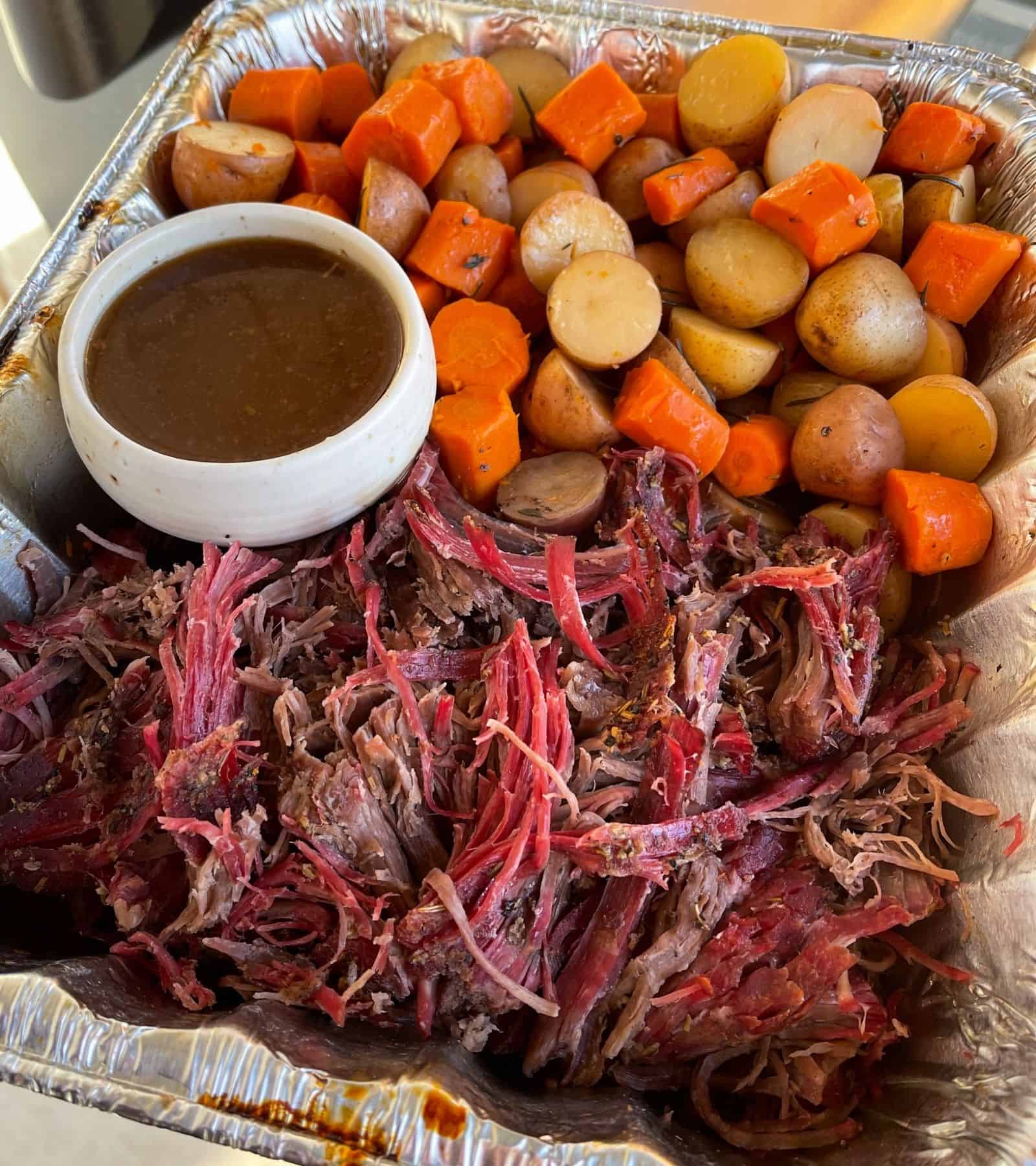
Traeger Smoked Pot Roast
Lean chuck tender roast seasoned and smoked before slow cooking with vegetables, herbs, and a rich beef bone broth until fall-apart-tender.
Ingredients
- 2.5 pound Chuck Tender Roast, fat trimmed*
- 1 Tablespoon Kosher Salt
- 1 teaspoon Garlic Powder
- 1 teaspoon Onion Powder
- 1 teaspoon Black Pepper
- 1/2 teaspoon Dried Rosemary
For Braising
- 1.5 pounds Baby Potatoes, halved
- 1 pound Carrots, peeled and cut into 2" pieces
- 2 cups Beef Broth
- 2 Tablespoons Red Wine Vinegar
- 1 Tablespoon Worcestershire
- 1-2 sprigs Fresh Thyme and Rosemary (optional)
For the Gravy
- 2 Tablespoons (16g) Cornstarch
- 2 Tablespoons Water
Instructions
- Pat the roast dry with a paper towel and mix the roast seasoning together. Rub the seasoning on the roast and set aside while your smoker preheats to 200ºF for 15 minutes with the lid closed.
- Smoke the roast for 90 minutes.
- In the last 10-15 minutes of smoking, prepare the carrots, potatoes, and braising liquid. Place everything in a 13x9 disposable foil pan or Dutch oven. (You can put the foil pan on top of a sheet pan for easier handling.)
- Push the veggies to the sides, creating a slight well so the bottom of the roast is submerged in the liquid.
- Cover tightly with foil and place back in the smoker. Increase the temperature to 300ºF and cook for another 4 hours or until the internal temperature reaches 200ºF to 205ºF.
- Let the pot roast rest, covered, for 15-20 minutes before slicing or shredding.
- While resting, drain the juices into a pot over medium heat to reduce to a gravy. Mix the cornstarch and water together to make a slurry. Add to the pot and stir well until evenly incorporated. Continue cooking until the gravy thickens.
- Remove any stems from the herbs and plate the vegetables and roast with gravy.
Notes
*Chuck Tender Roast, Bottom Round Roast, and Eye of Round Roast are all acceptable options for this pot roast.
Each serving has 8 WW SmartPoints (blue).
Recipe adapted from the original Traeger pot roast.
Nutrition Information:
Yield: 8 Serving Size: 7 oz Roast and Vegetables + 3 Tablespoons GravyAmount Per Serving: Calories: 305Total Fat: 8gCarbohydrates: 22gProtein: 34g
